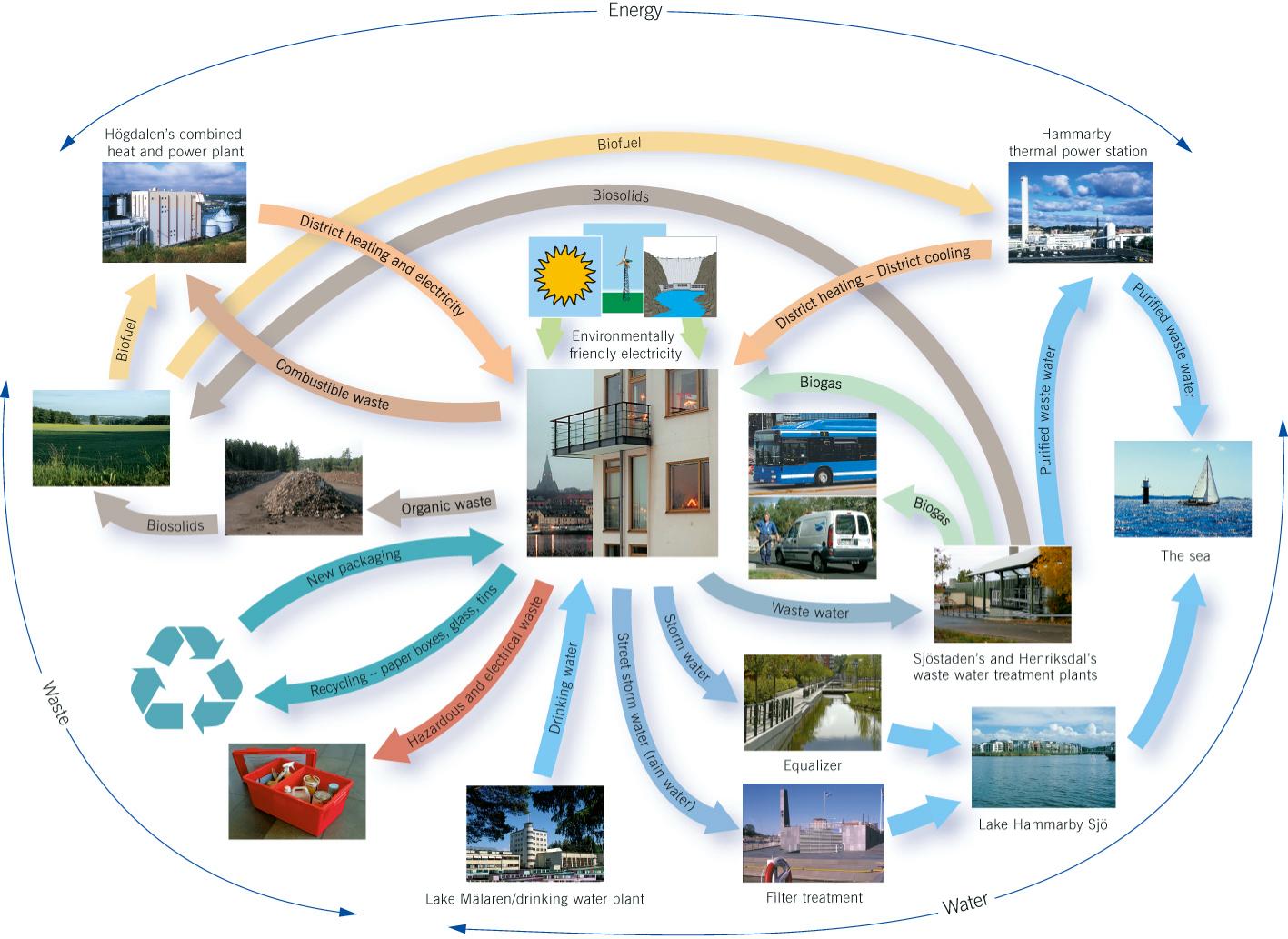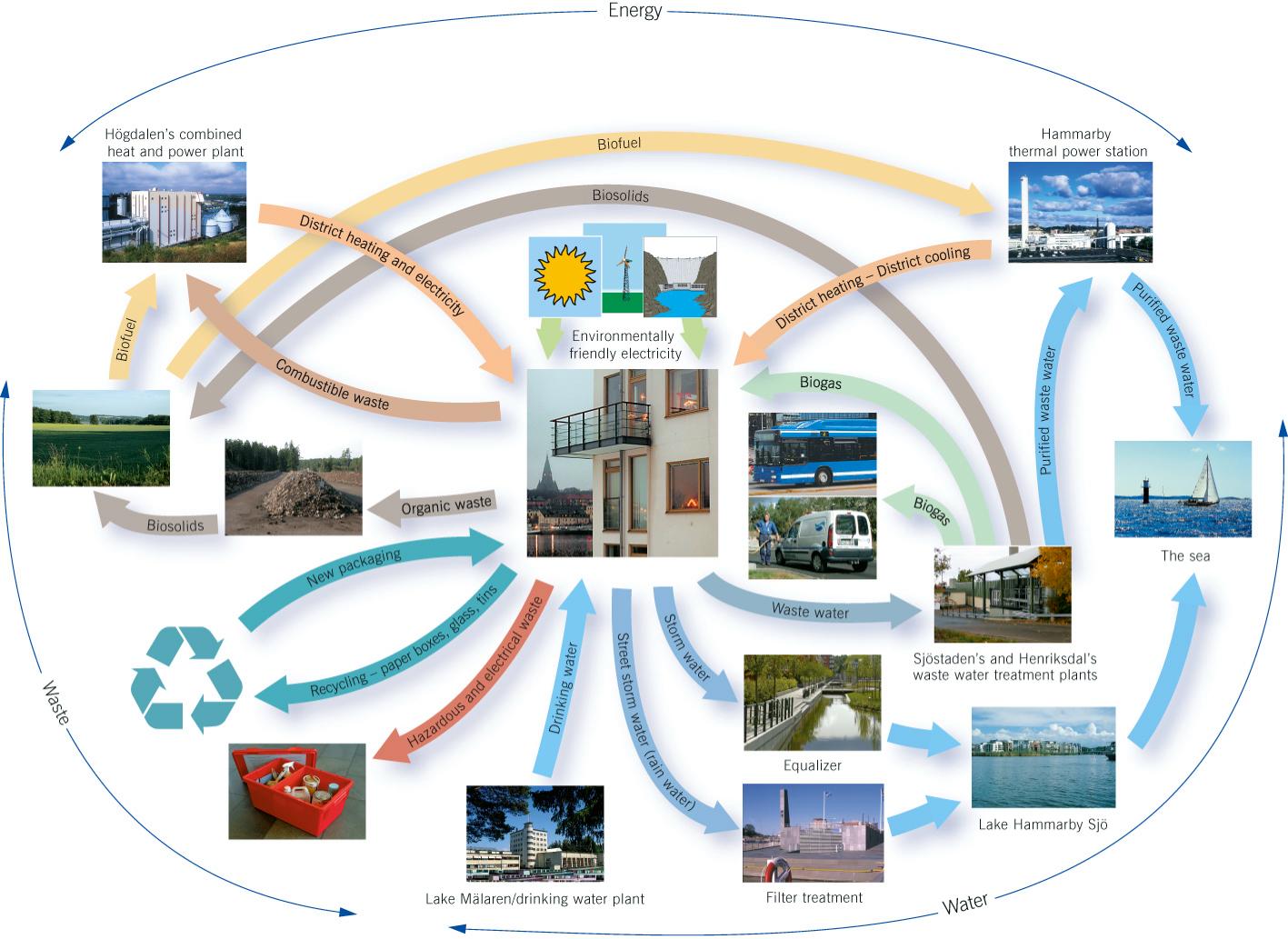 Hammarby Sjostad “eco-cycle”Source: HammarbySjostad.de
Hammarby Sjostad “eco-cycle”Source: HammarbySjostad.de
Residents of Hammarby Sjöstad, a district on the south side of Stockholm, Sweden, don’t let their waste go to waste. Every building in the district boasts an array of pneumatic tubes, like larger versions of the ones that whooshed checks from cars to bank tellers back in the day. One tube carries combustible waste to a plant where it is burned to make heat and electricity. Another zips food waste and other biomatter away to be composted and made into fertilizer. Yet another takes recyclables to a sorting facility.
Secure · Tax deductible · Takes 45 SecondsSecure · Tax deductible · Takes 45 SecondsMeanwhile, wastewater is taken to a treatment plant, from whence it emerges as biosolids for more compost, biogas for heat and transportation fuel, and pure water to cool a power plant, which also runs on biofuels grown with the biosolids. Looking at a chart of all this is enough to induce dizziness. “In terms of what you can do at the local level for energy efficiency and renewable energy, it’s incredible. It’s just amazing,” says Joan Fitzgerald, author of Emerald Cities (Oxford University Press, 2010).
After they are done, district authorities hope Hammarby Sjöstad will produce about half its power independently, a task made easier by the fact that residents, thanks to a broad range of efficiency and conservation measures, will consume half the energy of the average Swede (who already consumes only about 75 percent as much as the average American). These intrepid Swedish urbanites are pushing the envelope on a phenomenon catching on in cities across the developed world: “distributed energy.”
That’s the beginning of my new piece for Scientific American, “Local Power: Tapping Distributed Energy in 21st-Century Cities.” Click on over to read the rest. I want to add a few quick things here.
First, the piece is focused mostly on technology, since I assumed that’s what most Scientific American readers are curious about, but the primary barriers to distributed energy are not technological but institutional. Changing the way electric utilities (and their regulators) operate, changing financial institutions and mechanisms, creating more cohesive regional governing authorities, planning across sectors to reduce emissions, and growing carbon markets — all these have to do with changes in law and practice.
Second, yeah, yeah, solar panels are expensive. But cogeneration isn’t. Passive solar space and water heating are cheap. Geothermal heat pumps are economical. Burning methane from wastewater treatment and landfill facilities is cost-effective. In many areas biomass is renewable and relatively inexpensive for combined heat and power. District heating is lowering costs all over northern Europe. And of course efficiency is cost negative.
Efficiency — the other half of distributed energy — pays for the rest. That doesn’t just mean more efficient appliances and cars, but more efficient metropolitan systems. Sensors and microchips are getting cheaper so fast that pretty soon it will be possible to wire everything. Information about where energy is being generated and consumed, where traffic is congested, which parking spaces are occupied, where fresh and wastewater are flowing and how much, will be available at every node in the network. With that kind of information and the computing algorithms to make sense of it available to every building, vehicle, and consumer device, it will be possible to institute variable pricing for everything from energy to congestion to parking to water. Efficiency will be infused into the system rather than tacked on.
Third, the social effects of distributed energy are among its most intriguing aspects, but also most difficult to predict. Recall what happened when computing and information technology became widely available. Now imagine the hackers of the future with their hands on local energy management. The very notion probably makes Dick Cheney lose sleep at night (if he sleeps at all), but our kids and grandkids will take their ability to shape their environment for granted. As with the internet, the furious pace of distributed innovation will produce benefits that dwarf the security risks.
More prosaically, local distributed energy just requires more civic involvement. Efficient living spaces are by nature smaller, so there’s more time spent in communal spaces. There’s trash sorting and thermostat programming and community planning and all the rest. Several sources I spoke to for the story waxed poetic about the cities and districts pursuing distributed energy, how the effort became a source of civic pride and engagement. As Bill McKibben puts it in a beautifully wrought essay, Hammarby Sjöstad is “a place that makes sense.”




